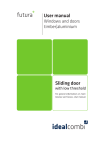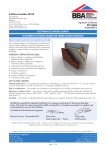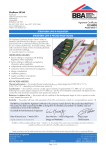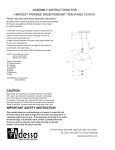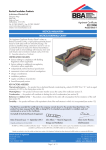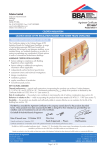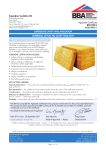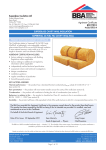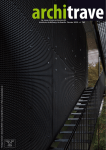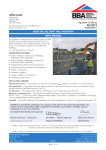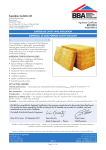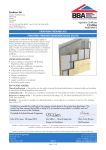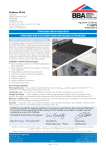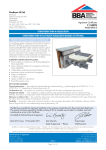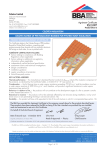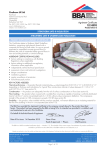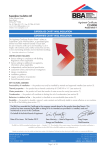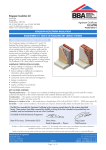Download Framed Wall BBA Certificate
Transcript
Recticel Insulation Products APPROVAL INSPECTION TESTING CERTIFICATION (a division of Recticel Ltd) Enterprise Way Meir Park Stoke on Trent Staffordshire ST3 7UN Tel: 01782 590470 Fax: 01782 590497 TECHNICAL APPROVALS FOR CONSTRUCTION Agrément Certificate 02/3905 e-mail: [email protected] website: www.recticelinsulation.co.uk Product Sheet 3 EUROTHANE GP EUROTHANE GP TIMBER FRAME BOARD This Agrément Certificate Product Sheet(1) relates to Eurothane GP Timber Frame Board, rigid polyisocyanurate foam board with a composite foilfacing on both sides for use between studding, or as an insulated lining, or as an insulated sheathing over new or existing walls of conventional timber-frame dwellings or similar buildings with a masonry outer leaf. (1) Hereinafter referred to as ‘Certificate’. CERTIFICATION INCLUDES: • factors relating to compliance with Building Regulations where applicable • factors relating to additional non-regulatory information where applicable • independently verified technical specification • assessment criteria and technical investigations • design considerations • installation guidance • regular surveillance of production • formal three-yearly review. KEY FACTORS ASSESSED Thermal performance — the product has a declared thermal conductivity* (λ90/90 value) of 0.022 W·m–1·K–1 (see section 6). Condensation — the insulation core has a water vapour resistivity of approximately 300 MN·s·g–1·m–1 and each foilfacing has a high water vapour resistance of 4000 MN·s·g–1, but the risk of interstitial condensation will depend on the wall construction and should be assessed for each project (see section 7). Behaviour in relation to fire — a wall incorporating the product has been tested to BS 476-21 : 1987 (see section 8). Durability — the product is durable and sufficiently stable to remain effective as an insulant for the life of the building (see section 14). The BBA has awarded this Certificate to the company named above for the product described herein. This product has been assessed by the BBA as being fit for its intended use provided it is installed, used and maintained as set out in this Certificate. On behalf of the British Board of Agrément Date of First issue: 30 August 2012 Sean Moriarty — Head of Approvals Greg Cooper Energy and Ventilation Chief Executive The BBA is a UKAS accredited certification body — Number 113. The schedule of the current scope of accreditation for product certification is available in pdf format via the UKAS link on the BBA website at www.bbacerts.co.uk Readers are advised to check the validity and latest issue number of this Agrément Certificate by either referring to the BBA website or contacting the BBA direct. British Board of Agrément Bucknalls Lane Garston, Watford Herts WD25 9BA ©2012 Page 1 of 9 tel: 01923 665300 fax: 01923 665301 e-mail: [email protected] website: www.bbacerts.co.uk Regulations In the opinion of the BBA, Eurothane GP Timber Frame Board, if installed, used and maintained in accordance with this Certificate, will meet or contribute to meeting the relevant requirements of the following Building Regulations (the presence of a UK map indicates that the subject is related to the Building Regulations in the region or regions of the UK depicted): The Building Regulations 2010 (England and Wales) Requirement: B3(1) Internal fire spread (structure) Comment: Requirement: C2(c) Resistance to moisture Comment: Requirement: L1(a)(i) Conservation of fuel and power Comment: Requirement: Regulation 7 Materials and workmanship Comment: The product is acceptable. See section 14 and the Installation part of this Certificate. Walls incorporating the product can meet this Requirement. See sections 8.1 and 8.2 of this Certificate. The product can contribute to satisfying this Requirement. See sections 7.1 and 7.4 of this Certificate. The product is acceptable. See sections 6.1 and 6.2 of this Certificate. The Building (Scotland) Regulations 2004 (as amended) Regulation: 8(1) Regulation: Standard: 9 2.6 3.15 6.1(b) 6.2 7.1(a)(b) Statement of sustainability The product can contribute to meeting the relevant requirements of Regulation 9, Standards 1 to 6 and therefore will contribute to a construction meeting a bronze level of sustainability as defined in this Standard. In addition, the product can contribute to a construction meeting a higher level of sustainability as defined in this Standard, with reference to clauses 7.1.4(1)(2) [Aspects 1(1)(2) and 2(1)], 7.1.6(1)(2) [Aspects 1(1)(2) and 2(1)] and 7.1.7(1)(2) [Aspect 1(1)(2)]. See section 6.1 of this Certificate. Comment: Regulation: Carbon dioxide emissions Building insulation envelope The product can contribute to satisfying clauses, or parts of clauses, 6.1.6(1), 6.2.1(1)(2), 6.2.3(1), 6.2.4(2), 6.2.5(2), 6.2.9(1), 6.2.10(1), 6.2.11(1)(2), 6.2.12(2) and 6.2.13(1)(2) of these Standards. See sections 6.1 and 6.2 of this Certificate. Comment: Standard: Condensation The product can contribute to satisfying this Standard, with reference to clauses 3.15.1(1)(2), 3.15.4(1)(2) and 3.15.5(1)(2). See sections 7.1 and 7.5 of this Certificate. Comment: Standard: Standard: Building standards — construction Spread to neighbouring buildings Walls incorporating the product can satisfy this Standard, with reference to clause 2.6.1(1)(2). See sections 8.1 and 8.2 of this Certificate. Comment: Standard: Fitness and durability of materials and workmanship The product can contribute to a construction meeting this Regulation. See section 14 and the Installation part of this Certificate. Comment: 12 Building standards — conversions Comments made in relation to this product under Regulation 9, Standards 1 to 6 also apply to this Regulation, with reference to clause 0.12.1(1) and Schedule 6(1). Comment: (1) Technical Handbook (Domestic). (2) Technical Handbook (Non-Domestic). The Building Regulations (Northern Ireland) 2000 (as amended) Regulation: B2 Fitness of materials and workmanship Comment: Regulation: C5 Condensation Comment: Regulation: E4(1) Internal fire spread — Structure Comment: Regulation: Regulation: F2(a)(i) F3(2) Conservation measures Target carbon dioxide Emission Rate Comment: The product is acceptable. See section 14 and the Installation part of this Certificate. Walls incorporating the product can satisfy this Regulation. See section 7.1 of this Certificate. Walls incorporating the product can satisfy this Regulation. See sections 8.1 and 8.2 of this Certificate. The product is acceptable. See sections 6.1 and 6.2 of this Certificate. Construction (Design and Management) Regulations 2007 Construction (Design and Management) Regulations (Northern Ireland) 2007 Information in this Certificate may assist the client, CDM co-ordinator, designer and contractors to address their obligations under these Regulations. See section: 3 Delivery and site handling (3.3) of this Certificate. Page 2 of 9 Additional Information NHBC Standards 2011 NHBC accepts the use of Eurothane GP Timber Frame Board, provided it is installed, used and maintained in accordance with this Certificate, in relation to NHBC Standards, Chapter 6.2 External timber framed walls. CE marking The Certificate holder has taken the responsibility of CE marking the product in accordance with harmonised European Standard BS EN 13165 : 2008. An asterisk (*) appearing in this Certificate indicates that data shown is given in the manufacturer’s Declaration of Performance. Technical Specification 1 Description 1.1 Eurothane GP Timber Frame Board is a rigid polyisocyanurate foam board with a composite foil-facing on both sides. 1.2 The product is either fixed between studding, or as an insulated dry lining or insulated sheathing facing the cavity. 1.3 The board has the nominal characteristics as shown in Table 1. Table 1 Nominal characteristics Length* (mm) 2400 Width* (mm) 1200 Thickness* (mm) 30 to 200 Minimum compressive strength at 10% compression* (kPa) 140 Edge profile Plain 2 Manufacture 2.1 Raw materials are injected onto the lower foil-facer on a conveyor belt. The exothermic reaction expands the foam, which then comes into contact with the upper foil-facer. An automated process cures and cuts the product to the required size. 2.2 As part of the assessment and ongoing surveillance of product quality, the BBA has: • agreed with the manufacturer the quality control procedures and product testing to be undertaken • assessed and agreed the quality control operated over batches of incoming materials • monitored the production process and verified that it is in accordance with the documented process • evaluated the process for management of nonconformities • checked that equipment has been properly tested and calibrated • undertaken to carry out the above measures on a regular basis through a surveillance process, to verify that the specifications and quality control operated by the manufacturer are being maintained. 2.3 The management system of Recticel Insulation Products has been assessed and registered as meeting the requirements of BS EN ISO 9001 : 2008 by Lloyd’s Register Quality Assurance (Certificate [ANT951267.1]). 3 Delivery and site handling 3.1 The product is delivered to site shrink-wrapped in polythene packs containing a label with the product description and characteristics, the manufacturer’s name, and the BBA identification mark incorporating the number of this Certificate. 3.2 It is essential that the product is stored such that it is raised off the ground, is inside or under cover on a flat, dry, level surface in a well-ventilated area. The product must be protected from rain, snow and prolonged exposure to sunlight. Boards that have been allowed to get wet or that are damaged must not be used. Nothing should be stored on top of boards. 3.3 The product must not be exposed to a naked flame or other ignition sources. The product must not be exposed to solvents or other chemicals. Assessment and Technical Investigations The following is a summary of the assessment and technical investigations carried out on Eurothane GP Timber Frame Board. Page 3 of 9 Design Considerations 4 General 4.1 Eurothane GP Timber Frame Board is effective in reducing the U value (thermal transmittance) of external walls of timber-frame dwellings. It is essential that such walls are designed and constructed to incorporate the normal precautions against moisture ingress, including a breather membrane over the timber sheathing. 4.2 New buildings subject to the national Building Regulations should be designed in accordance with the relevant recommendations of BS EN 1995-1-1 : 2004, BS 5589 : 1989 and BS EN 351-1 : 1996. 4.3 Constructions incorporating a masonry outer leaf (includes masonry units and natural stone blocks) should be in accordance with BS EN 1996-1-1 : 2005 and BS EN 1996-2 : 2006. The designed residual cavity width should be 50 mm. 4.4 It is recommended that services which penetrate the dry lining, eg, light switches, power outlets, are kept to a minimum to limit damage to vapour checks. In addition, any penetrations should be either enclosed in plasterboard or stone mineral wool or a suitably tested proprietary fire-rated system in order to preserve the fire resistance of the wall. 4.5 Installation must not be carried out until the moisture content of the timber frame is less than 20%. 4.6 Eurothane GP Timber Frame Board, when used as insulated sheathing, will not contribute to the structural performance of the timber frame. 4.7 Installation of plasterboard must be in accordance with the relevant sections of BS 8212 : 1995. 5 Practicability of installation The product is designed to be installed by a competent general builder, or a contractor, experienced with this type of product. 6 Thermal performance 6.1 Calculations of the thermal transmittance (U value) should be carried out in accordance with BS EN ISO 6946 : 2007 and BRE Report (BR 443 : 2006) Conventions for U-value calculations using the declared thermal conductivity* (λ90/90) value of 0.022 W·m–1·K–1 and an emissivity value of 0.2 for the foil-facer. The U value of a completed wall will depend on the selected insulation thickness, the insulating value of the external substrate masonry and the internal finish. When considering insulation requirements, designers should refer to the detailed guidance contained in the documents supporting the national Building Regulations. The U values shown in Table 2 indicate that the product can contribute to a wall achieving typical design U values referred to in those supporting documents. Table 2 U values (1) Stud size (mm) Eurothane GP Timber Frame Board between studs (mm)(2) U Value (W·m–2·K–1) 60 75 85 90 100 115 130 150 0.35 0.30 0.28 0.27 0.25 0.23 0.22 0.19 140 140 140 140 140 140 140 200 (1) Typical timber-frame construction comprising 102 mm brick leaf, 50 mm unventilated air cavity, 13 mm sheathing board, 15% timber studs, 12.5 mm plasterboard and 3 mm plaster. (2) Nearest available thickness. 6.2 The product can maintain, or contribute to maintaining, continuity of thermal insulation at junctions between elements and openings. For Accredited Construction Details the corresponding psi values in BRE Information Paper IP 1/06 Assessing the effects of thermal bridging at junctions and around openings, Table 3 may be used in carbon emission calculations in Scotland and Northern Ireland. Detailed guidance for other junctions and on limiting heat loss by air infiltration can be found in: England and Wales — Approved Documents to Part L and for new thermal elements to existing buildings, Accredited Construction Details (version 1.0). See also SAP 2009 Appendix K and the iSBEM User Manual for new-build Scotland — Accredited Construction Details (Scotland) Northern Ireland — Accredited Construction Details (version 1.0). Page 4 of 9 7 Condensation Interstitial condensation 7.1 Walls will limit the risk of interstitial condensation adequately when they are designed and constructed in accordance with BS 5250 : 2011, Annexes D and G and the relevant guidance. A VCL must be used. 7.2 For the purposes of assessing the risk of interstitial condensation, the insulation core vapour resistivity may be taken as approximately 300 MN·s·g–1·m–1 and a resistance value of 4000 MN·s·g–1 for each individual foil-facing. 7.3 The joints between the Eurothane GP Timber Frame Board when used as insulated sheathing, must not be taped. If the product is to be used in the external walls of rooms expected to have high humidity, care must be taken to provide adequate permanent ventilation to avoid possible problems from the formation of interstitial condensation in the wall. 7.4 Walls will limit the risk of surface condensation adequately when the thermal transmittance (U value) does not exceed 0.7 W·m–2·K–1 at any point, and the junctions with floors, roofs and openings are designed in accordance with Limiting thermal bridging and air leakage : Robust construction details for dwellings and similar buildings TSO 2002, BRE Information Paper IP 1/06 or section 6.2 of this Certificate. 7.5 For buildings in Scotland, constructions will be acceptable where the thermal transmittance (U value) of the wall does not exceed 1.2 W·m–2·K–1 at any point and openings and junctions with other elements comply with the guidance given in Annex G of BS 5250 : 2011 or section 6.2 of this Certificate. Additional guidance can be found in BRE Report (BR 262 : 2002) Thermal insulation: avoiding risks. 8 Behaviour in relation to fire • • • • 8.1 A fire-resistance test was carried out in accordance with BS 476-21 : 1987 on a load bearing, timber stud wall system. An assessment considered the likely fire resistance of four systems (constructions described in section 8.2) as if they had been tested to 476-21 : 1987. The main points of the assessment highlighted the following: all four systems are suitable for applications where a fire resistance of up to 30 minutes is required against the loadbearing capacity, integrity and insulation criteria of BS 476-21 : 1987 (for fire exposure from the inside, when subject to a total imposed load of 60 kN (10 kN load per stud). A suitably qualified structural engineer must ensure that the stress applied to the studs in practice must not exceed the stress applied to the tested studs the internal leaf comprises of gypsum plasterboard, at least 12.5 mm thick, manufactured in the United Kingdom by Lafarge, British Gypsum or Knauf Drywall. The plasterboard must be secured in accordance with the manufacturers instructions timber studs must be at least 140 mm deep by 45 mm wide located at maximum 600 mm centres. The same sections are used to form cross noggins at maximum 1200 mm centres. The noggins between each pair of studs are staggered by 60 mm from the noggins in the adjacent pair of studs openings for doors and windows should be framed out and any exposed timber covered with at least one layer of plasterboard (see also section 4.4). 8.2 The four systems are: System 1 — Eurothane GP Timber Frame Board between studs only • outer brick leaf • nominal 50 mm air cavity • breather membrane • sheathing board — OSB or similar, at least 9 mm thick • 30 mm to 200 mm thick Eurothane GP Timber Frame Board between the studs, retained using timber battens, nominal 35 mm by 25 mm, secured to the sides of the studs. • vapour control layer (VCL) • 12.5 mm gypsum plasterboard. System 2 — Eurothane GP Timber Frame Board between studs and over studs (as insulated sheathing) • outer brick leaf • nominal 50 mm air cavity • 30 mm to 100 mm thick Eurothane GP Timber Frame Board against a breather membrane/sheathing board • breather membrane • sheathing board — OSB or similar, at least 9 mm thick • 30 mm to 200 mm thick Eurothane GP Timber Frame Board between the studs, retained using timber battens, nominal 35 mm by 25 mm, secured to the sides of the studs. • VCL • 12.5 mm gypsum plasterboard. Page 5 of 9 System 3 — Eurothane GP Timber Frame Board between studs and over studs (as insulated dry lining) • outer brick leaf • nominal 50 mm air cavity • breather membrane • sheathing board — OSB or similar, at least 9 mm thick • 30 mm to 200 mm thick Eurothane GP Timber Frame Board between the studs, retained using timber battens, nominal 35 mm by 25 mm, secured to the sides of the studs. • maximum 25 mm thick Eurothane GP Timber Frame Board against the internal face of timber studs • VCL (optional). Taping the insulation board joints with a foil tape to create a VCL • 12.5 mm gypsum plasterboard secured to vertical timber battens, 50 mm wide by 25 mm thick, using 38 mm screws at maximum 300 mm centres. The battens are secured through the insulation to each stud at maximum 300 mm centres using screws long enough to penetrate the timber studs by at least 25 mm. System 4 — Over studs (as insulated sheathing) • outer brick leaf • nominal 50 mm air cavity • 30 mm to 200 mm thick Eurothane GP Timber Frame Board against a breather membrane/sheathing board • breather membrane • sheathing board — OSB or similar, at least 9 mm thick • no insulation between the studs • VCL • 12.5 mm gypsum plasterboard. 8.3 The product is classified as ‘combustible’. 8.4 Cavity barriers must be provided to comply with: England and Wales — Approved Document B, Volume 1, Section 6, and Volume 2, Section 9 Scotland — Mandatory Standard 2.4, clauses 2.4.1(1)(2), 2.4.2(1)(2), 2.4.7(1) and 2.4.9(2) (1) Technical Handbook (Domestic). (2) Technical Handbook (Non-Domestic). Northern Ireland — Technical Booklet E, paragraphs 3.35 to 3.38. 9 Proximity of flues and appliances When installing the product in close proximity to certain flue pipes and/or heat-producing appliances, the following provisions to the national Building Regulations are applicable: England and Wales — Approved Document J, sections 1 to 4 Scotland — Mandatory Standard 3.19, clauses 3.19.1(1)(2) to 3.19.9(1)(2) (1) Technical Handbook (Domestic). (2) Technical Handbook (Non-Domestic). Northern Ireland — Technical Booklet L, sections 1 to 4. 10 Weathertightness 10.1 Constructions incorporating the products and built in accordance with sections 4.2 and 4.3 will resist the transfer of precipitation to the inner leaf and satisfy the national Building Regulations: England and Wales — Requirement C2(b)(c) Scotland — Mandatory Standard 3.10, clause 3.10.5(1)(2) (1) Technical Handbook (Domestic). (2) Technical Handbook (Non-Domestic). Northern Ireland — Regulation C4. 10.2 In all situations it is particularly important to ensure during installation that: • wall ties and fixings are installed correctly and are thoroughly clean • excess mortar is cleaned from the cavity face of the brick leaf and any debris removed from the cavity • installation is carried out to the highest level on each wall or the top edge of the insulation is protected by a cavity tray • at lintel level, a cavity tray, stop ends and weepholes, must be provided. 11 De-rating of electrical cables As with other insulation products, it may be necessary in some cases to de-rate electrical cables buried in insulation. In BS 7671 : 2008 it is suggested that where wiring is completely surrounded by insulation, it may need to be de-rated to as low as half its free air current carrying capacity. Guidance should be sought from a qualified electrician. Page 6 of 9 12 Infestation Use of the product does not in itself promote infestation. The creation of voids within the structure may provide habitation for insects or vermin in areas already infested. Care should be taken to ensure, wherever possible, that all voids are sealed, as any infestation may be difficult to eradicate. There is no food value in the materials used. 13 Maintenance As the product is confined behind the wall lining and it has suitable durability (see section 14), maintenance is not required. 14 Durability The board is rot proof, stable and durable and will have a life equivalent to that of the wall structure in which they are incorporated. Installation 15 General 15.1 Installation of the product should be in accordance with the Certificate holder’s instructions and current good building practice. 15.2 The board is light to handle, and cut easily but care must be taken to prevent damage, particularly at edges. Between studs 15.3 The product should be cut to fit tightly between the timber studding and positioned against the inner face of the sheathing board. Any gaps should be filled with expanding insulation foam. The insulation should be held in place by nails or timber battens to the warm side of the insulation. 15.4 The void created by space between the inner surface of the product and the dry lining can be utilised as an insulated service duct. 15.5 A sealed polythene VCL with a minimum thickness of 0.125 mm (500 gauge) and lapped and sealed joints is placed over the stud face before applying the internal finish. Over studs (as insulated dry lining) 15.6 Mineral wool insulation or the product should be cut to fit snuggly between the timber studding. 15.7 A maximum 25 mm thick Eurothane GP Timber Frame Board is temporarily fixed to the inner face of the timber studding ensuring that the insulation makes contact or over laps with ceiling and floor insulation. 15.8 The line of the timber studs is marked on the product to allow fixing of vertical timber battens and plasterboard. 15.9 The product is butted tightly against each other to prevent gaps. Taping the joints with a durable acrylic adhesive foil tape provides an effective VCL and an air permeability barrier. To achieve an adequate bond, the boards should be thoroughly clean and free from any contamination. 15.10 The insulation is sealed at all service penetrations. 15.11 Plasterboard is fixed to vertical timber battens (50 mm wide by 25 mm thick) and secured with 38 mm screws at maximum 300 mm centres, and finished as normal. The battens are secured through the insulation to each stud at maximum 300 mm centres using screws which penetrate the timber studs by at least 25 mm. Over studs (as sheathing insulation) 15.12 When required, mineral wool insulation or the product should be cut to fit fully between the timber studding. 15.13 The Eurothane GP Timber Frame Board is fixed outside the breather membrane on the external surface and fixed with galvanised clout nails at 300 mm centres around the perimeter of the board and at 400 mm centres along any intermediate timbers. 15.14 The boards are closely butted and joints are staggered. 15.15 The outer face of the boards must not be taped. 15.16 Helical stainless steel wall ties are then driven through the insulation into the timber studs ensuring that they slope down toward the outer leaf. 15.17 Internal finishes are applied as normal (see section 15.5). Page 7 of 9 Technical Investigations 16 Tests Tests were carried out on Eurothane GP Timber Frame Board by the BBA in accordance with BS EN 13165 : 2008 to determine: • dimensional stability • compressive strength • thermal conductivity • compressive creep. 17 Investigations 17.1 The manufacturing process was examined, including the methods adopted for quality control, and details were obtained of the quality and composition of the materials used. 17.2 An assessment was made of the results of test data to BS EN 13165 : 2008 in relation to: • dimensions • density • λ value. 17.3 An assessment of the risk of interstitial condensation was made. 17.4 An assessment was made of typical constructions which achieve the design U values. Bibliography BS 476-21 : 1987 Fire tests on building materials and structures — Methods for determination of the fire resistance of loadbearing elements of construction BS 5250 : 2011 Code of practice for control of condensation in buildings BS 5589 : 1989 Code of practice for preservation of timber BS 7671 : 2008 Requirements for electrical installations. IEE Wiring Regulations. Seventeenth Edition BS 8212 : 1995 Code of practice for dry lining and partitioning using gypsum plasterboard BS EN 351-1 : 1996 Durability of wood and wood-based products — Preservative-treated solid wood — Classification of preservative penetration and retention BS EN 1995-1-1 : 2004 Eurocode 5 : Design of timber structures — General — Common rules and rules for buildings BS EN 1996-1-1 : 2005 Eurocode 6 : Design of masonry structures — General rules for reinforced and unreinforced masonry structures BS EN 1996-2 : 2006 Eurocode 6 : Design of masonry structures — Design considerations, selection of materials and execution of masonry BS EN 13165 : 2008 Thermal insulation products for buildings — Factory made rigid polyurethane foam (PUR) products — Specification BS EN ISO 6946 : 2007 Building components and building elements — Thermal resistance and thermal transmittance — Calculation method BS EN ISO 9001 : 2008 Quality management systems — Requirements Page 8 of 9 Conditions of Certification 18 Conditions 18.1 This Certificate: • relates only to the product/system that is named and described on the front page • is issued only to the company, firm, organisation or person named on the front page — no other company, firm, organisation or person may hold or claim that this Certificate has been issued to them • is valid only within the UK • has to be read, considered and used as a whole document — it may be misleading and will be incomplete to be selective • is copyright of the BBA • is subject to English Law. 18.2 Publications, documents, specifications, legislation, regulations, standards and the like referenced in this Certificate are those that were current and/or deemed relevant by the BBA at the date of issue or reissue of this Certificate. 18.3 This Certificate will remain valid for an unlimited period provided that the product/system and its manufacture and/or fabrication, including all related and relevant parts and processes thereof: • are maintained at or above the levels which have been assessed and found to be satisfactory by the BBA • continue to be checked as and when deemed appropriate by the BBA under arrangements that it will determine • are reviewed by the BBA as and when it considers appropriate. 18.4 The BBA has used due skill, care and diligence in preparing this Certificate, but no warranty is provided. 18.5 In issuing this Certificate, the BBA is not responsible and is excluded from any liability to any company, firm, organisation or person, for any matters arising directly or indirectly from: • the presence or absence of any patent, intellectual property or similar rights subsisting in the product/system or any other product/system • the right of the Certificate holder to manufacture, supply, install, maintain or market the product/system • actual installations of the product/system, including their nature, design, methods, performance, workmanship and maintenance • any works and constructions in which the product/system is installed, including their nature, design, methods, performance, workmanship and maintenance • any loss or damage, including personal injury, howsoever caused by the product/system, including its manufacture, supply, installation, use, maintenance and removal • any claims by the manufacturer relating to CE marking. 18.6 Any information relating to the manufacture, supply, installation, use, maintenance and removal of this product/ system which is contained or referred to in this Certificate is the minimum required to be met when the product/system is manufactured, supplied, installed, used, maintained and removed. It does not purport in any way to restate the requirements of the Health and Safety at Work etc. Act 1974, or of any other statutory, common law or other duty which may exist at the date of issue or reissue of this Certificate; nor is conformity with such information to be taken as satisfying the requirements of the 1974 Act or of any statutory, common law or other duty of care. British Board of Agrément Bucknalls Lane Garston, Watford Herts WD25 9BA ©2012 Page 9 of 9 tel: 01923 665300 fax: 01923 665301 e-mail: [email protected] website: www.bbacerts.co.uk









